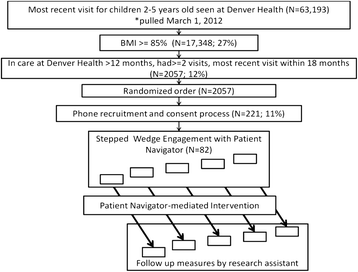A randomized, home-based, childhood obesity intervention delivered by patient navigators
- PMID: 26002612
- PMCID: PMC4492174
- DOI: 10.1186/s12889-015-1833-z
A randomized, home-based, childhood obesity intervention delivered by patient navigators
Abstract
Background: Although Colorado is perceived as a healthy state, in 2010, 14.1 % of children aged 2-5 were overweight and 9.1 % were obese. Despite the high prevalence of obesity in this population, evidence to support particular strategies to treat obese preschoolers is lacking. The efficacy of home-based, childhood obesity interventions to reduce a child's body mass index is inconclusive. However, this model uniquely provides an opportunity to observe and intervene with the home food and activity environment and engage the entire family in promoting changes that fit each family's unique dynamics.
Methods/design: Eligible participants are children aged 2-5 years who attended a well-child care visit at a Denver Health Community Health Service clinic within 12 months prior to recruitment and on that visit had a body mass index (BMI) >85th percentile-for-age. Participants are randomly recruited at study inception and allocated to the intervention in one of five defined 6-month stepped wedge engagements; the delayed intervention groups serves as control groups until the start of the intervention. The program is delivered by a patient navigator at the family' home and consists of a 16-session curriculum focused on 1) parenting styles, 2) nutrition, and 3) physical activity. At each visit, a portion of curriculum is delivered to guide parents and children in selecting one goal for behavior change in each of three work areas to work on during the following week. The primary study outcome measure is change in BMI z-score from baseline to post-intervention period.
Discussion: This childhood obesity study, innovative for its home-based intervention venue, provides rich data characterizing barriers and facilitators to healthy behavior change within the home. The study population is innovative as it is focused on preschool-aged, Latino children from low-income families; this population has not typically been targeted in obesity management assessments. The home-based intervention is linked to clinical care through update letters and assessment of the program's impact to the child's medical providers. Informing primary care providers about a child's accomplishments and challenges, allows the clinician to support the health weight effort when seeing families during subsequent clinical visits.
Trial registration: ClinicalTrials.gov NCT02024360 Registered December 21, 2013.
Figures
References
-
- Ogden CL, Flegal KM. Changes in terminology for childhood overweight and obesity. National Health Statistics Reports. 2010;25:1–5. - PubMed
-
- May AL, Freedman D, Sherry B, Blanck HM, Centers for Disease C, Prevention Obesity - United States, 1999–2010. Morbidity Mortality Weekly Report Surveillance Summaries. 2013;62(Suppl 3):120–8. - PubMed
Publication types
MeSH terms
Associated data
Grants and funding
LinkOut - more resources
Full Text Sources
Other Literature Sources
Medical


